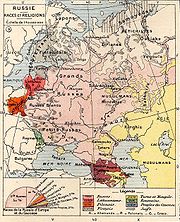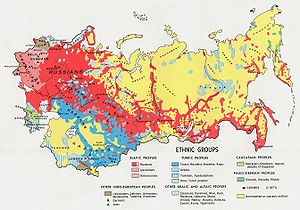
Ethnic groups in Russia
Encyclopedia


Federal subjects of Russia
Russia is a federation which, since March 1, 2008, consists of 83 federal subjects . In 1993, when the Constitution was adopted, there were 89 federal subjects listed...
which constitute the Russian Federation, there are 21 national republics (meant to be home to a specific ethnic minority), 5 autonomous okrugs (usually with substantial or predominant ethnic minority) and an autonomous oblast
Jewish Autonomous Oblast
The Jewish Autonomous Oblast is a federal subject of Russia situated in the Russian Far East, bordering Khabarovsk Krai and Amur Oblast of Russia and Heilongjiang province of China. Its administrative center is the town of Birobidzhan....
.
Committee of Ministers of Council of Europe in May 2007 issued concern that Russia still hasn't adopted comprehensive anti-discrimination legislation, and the existing anti-discrimination provisions are seldom used in spite of reported cases of discrimination.
Committee of Ministers in 2007 noted certain setbacks in minority participation in public life, including the abrogation of federal provisions for quotas for indigenous people in regional legislatures.
Although the Constitution of the Russian Federation recognizes Russian as the official language, the individual republics may declare one or more official languages. Most of subjects have at least two — Russian and the language of the "eponymous" nationality. As Ministers noted in 2007, there is a lively minority language scene in most subjects of the federation, with more than 1,350 newspapers and magazines, 300 TV channels and 250 radio stations in over 50 minority languages. Moreover, new legislation allows usage of minority languages in federal radio and TV broadcasting.
In 2007, there were 6,260 schools which provided teaching in altogether 38 minority languages, and over 75 minority languages were taught as a discipline in 10,404 schools. Ministers of Council of Europe has noted efforts to improve the supply of minority language textbooks and teachers, as well as greater availability of minority language teaching. However, as Ministers has noted, there remain shortcomings in the access to education of persons belonging to certain minorities.
There are more than 2,000 national minorities' public associations and 560 national cultural autonomies, however the Committee of Ministers has noted that in many regions amount of state support for the preservation and development of minority cultures is still inadequate. There's a significant difference between "eponymous" ethnic groups and nationalities without their own national territory, as resources of the last are relatively limited.
"
Russia is also home of a particular category of minority peoples, i.e. small indigenous peoples of the North and Far East, who maintain very traditional lifestyles, often in a hazardous climatic environment, while adapting to the modern world. After the fall of the Soviet Union Russian Federation passed legislation to protect rights of small northern indigenous peoples. Gil-Robles has noted agreements between indigenous representatives and oil companies, which are to compensate potential damages on peoples habitats due to oil exploration. As Committee of Ministers of Council of Europe noted in 2007, despite some initiatives for development, the social and economic situation of numerically small indigenous peoples was affected by recent legislative amendments at the federal level, removing some positive measures as regards their access to land and other natural resources.
Committee of Ministers has noted in 2007 that despite efforts to improve access to residency registration and citizenship for national minorities, still those measures haven't regularised the situation of all the persons concerned.
See also
- Demographics of RussiaDemographics of RussiaThe demographics of Russia is about the demographic features of the population of the Russian Federation, including population growth, population density, ethnic composition, education level, health, economic status, and other aspects of the population....
- List of larger indigenous peoples of Russia
- List of small-numbered indigenous peoples of Russia
- List of extinct indigenous peoples of Russia
- Indigenous peoples of SiberiaIndigenous peoples of SiberiaIncluding the Russian Far East, the population of Siberia numbers just above 40 million people.As a result of the 17th to 19th century Russian conquest of Siberia and the subsequent population movements during the Soviet era, the demographics of Siberia today is dominated by native speakers of...
- Population by mother tongue and districts in 50 Governorates of the European Russia in 1897

